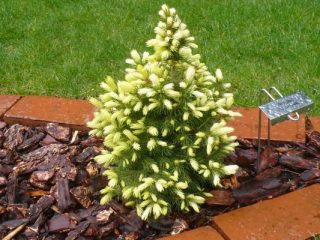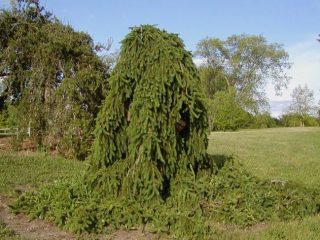Content
Dwarf spruce is a popular ornamental plant among gardeners. The culture is represented by many species and varieties, which differ in shades of needles and crown shape.
Are there dwarf spruce trees?
Ordinary spruce is a fairly tall tree up to 40 m or more above the ground. But some varieties and ornamental varieties are modest in size. They are convenient to grow in garden plots, since the trees do not have the most stringent care requirements and look harmonious in design.
Description of dwarf spruce trees
In general, dwarf spruce trees are not much different from tall ones.They have a taproot in the first 15 years and then a superficial root system, needle-shaped tetrahedral or flattened needles and scaly bark of a gray, reddish or brown hue. The color of the crown depends on the variety - there are bright green and bluish, bluish and golden miniature trees.
Low spruce usually has a wide pyramidal, conical or round shape. Unlike tall trees, it has good wind resistance and rarely dies during a squall.
Dwarf spruce blooms with male and female strobili. The former are responsible for pollination, and the latter eventually form small oblong cones. The seeds usually ripen in October and can be widely distributed throughout the area with the wind.

The disadvantage of miniature conifers is their vulnerability to fungi and their tendency to fade under the bright sun.
Height of dwarf spruce
Low spruce trees are divided into several categories based on growth. It is customary to distinguish the following types:
- low-growing - tree height is 3-8 m;
- dwarf - conifers stretch up to 0.4-1 m;
- miniature - plants reach a maximum of 30 cm.
There are also micro varieties up to only 3 cm in height. It is impossible to plant them on the site; usually such dwarf spruce trees are used for the home.
Types of low-growing spruce trees
Low-growing spruces for dachas are presented in a wide variety. Many species have miniature varieties no more than 4 m tall.
Common (Picea abies)
Dwarf varieties of common spruce reach 1.2-3 m in height. The trees usually have a pyramidal or cushion-shaped crown; the needles can be bright green or golden.
The species bears fruit with elongated brown cones. It enters the seeding period at the age of about 20 years, the total lifespan of the tree is on average 250 years.

Common spruce grows well on any soil composition, but the soil must be fertile
Prickly (Picea pungens)
Most varieties of this species grow up to 20 m, but there are also dwarf varieties up to only 2 m above the ground. Spruce has very sharp needles of a bluish, gray or silver hue, the length of the needles is 15-30 mm. The species produces cylindrical cones that are initially reddish or purple and then brown. Descriptions of blue dwarf spruce trees report that their crown is usually cylindrical, and quite narrow at a young age.

Prickly spruce loves well-moistened soil
Gray (Picea glauca)
The evergreen tree is represented by tall and dwarf varieties. It has a thin bark with a scaly structure, the needles in cross-section are diamond-shaped, blue-green, slightly whitish at the bottom. The shape of the crown of dwarf spruce trees is spherical or prostrate, nest-shaped.

Gray spruce easily tolerates unfavorable ecology and suffers little from gas pollution
Serbian (Picea omorika)
Dwarf varieties of this species rise up to 2-3.5 m above the ground. The crown of the trees is wide, up to 2.5 m in diameter, the needles are dark green above and bluish below.
Serbian spruce can only be found in its natural form in the Balkans. But it is bred in summer cottages all over the world, including in cold regions. The tree takes root well in difficult soils, including alkaline and acidic.

Serbian spruce is often used for sale as a New Year's tree.
Varieties of dwarf spruce trees with photos and descriptions
Photos of small spruce trees show that there are dozens of varieties of dwarf coniferous trees for the garden. Several of them deserve special attention.
Nidiformis
The dwarf variety forms a nest-like crown - the shoots fan out from the main trunk. The needles of the plant are thick and soft, up to 1 cm long. Spruce looks good in single plantings and group compositions. Every year it grows by about 3 cm in height and up to 7 cm in diameter.

In adulthood, Nidiformis reaches 1 m above the ground
Hermann Naue
The cushion-shaped dwarf spruce grows on average up to 80 cm. It spreads widely across, up to 2 m. It has thick and tough shoots, the shade of the needles is bluish-green. The variety produces red buds that gradually turn brown. Spruce can be grown in the middle zone and in the south.

Herman Nau has high drought resistance
Echiniformis
Dwarf spherical spruce up to 1 m grows well in moist soil with a slightly acidic composition. It gets along well with other conifers and is suitable for planting in group compositions. The plant's needles are bluish and quite soft. The tree is frost-resistant, but in winters with little snow it requires shelter.

The Echiniformis variety rises up to 60 cm above the ground
Daisy's White
Dwarf spruce does not rise above 1 m even after 10 years of life. It has shiny juicy green needles, long needles, up to 2 cm. Young shoots of the variety have a bright golden color.

The Daisy White variety does not tolerate waterlogged soil.
Lucky Strike
A low-growing variety of spruce up to 3 meters prefers to grow in well-lit areas and rarely fades in the sun. Loves moist, slightly acidic soil, does not grow well on calcareous soils. It has an irregularly shaped crown up to 1.5 m in diameter, the young branches of the tree are bright green or yellowish. The cones are crimson in the first stages of development, then become darker.

Lucky Strike is suitable for forming hedges
Glauca Globosa
The dwarf blue spruce called Glauka Globoza is unpretentious and easily tolerates polluted air and winter frosts. It has a spherical crown of bluish-gray color and emits a pleasant aroma. Reaches a maximum of 2 m in adulthood.

The Glauka Globoza variety was developed back in 1937
Little Gem
The dwarf variety rises only 50 cm above the ground and can spread up to 1 m to the sides. The needles of the tree are thick, light green, the needles are short, 2-5 mm each. Rigid branches are directed obliquely upward. The dwarf plant is grown not only in open ground, but also in containers.

Little Jam grows 2-3 cm per year
Pygmaea
The variety of low-growing spruce up to 2 meters is characterized by slow growth. Adds no more than 3-7 cm per year. It has a thick and dense crown, short dark green needles. In adulthood, the plant acquires wide-conical, uneven outlines. It prefers to grow in sunny areas; the variety needs slightly acidic soil with moderate moisture.

Pygmy spruce requires preventive treatments against fusarium and schutte
Formanek
Low-growing spruce spreads over an area of up to 1.5 m.At the same time, the height of the plant rarely exceeds 40-50 cm. The branches of the tree are drooping, weeping, the needles are grayish-green with a beautiful silvery tint. On the site, the dwarf variety should be placed in the sun, since in the shade the needles lose their original color.

The Formanek variety loves sandy and loamy soils
Recommendations for selection
When choosing a decorative dwarf spruce for a site, it is necessary to take into account the characteristics of the landscape and the plant itself. In particular, it is recommended to pay attention to the following points:
- Frost resistance. Many dwarf trees are heat-loving; the hardiest varieties should be selected for planting in regions with harsh climates.
- Drought resistance. Blue, low-growing conifers usually need the least watering in the summer.
- Reaction to sunlight. Many dwarf varieties of Norway spruce prefer to grow in open areas. But some varieties, in particular Canadian ones, often suffer from burns - it is better to plant them in shaded areas.
When choosing a conifer, you need to take into account the speed of its development. If a dwarf tree is to be used in the formation of a hedge, it is better to give preference to a fast-growing variety.
Planting and care
Photos and descriptions of dwarf blue spruce varieties show that growing a tree on a site is easy if you follow the basic rules. Planting is usually carried out in early autumn or spring before the start of active growing season. The location is chosen in accordance with the requirements of the particular variety. It is necessary to ensure that the area for the dwarf plant is not swampy.
Shortly before planting the conifer, the site is dug up and a hole is prepared that is twice the size of the root system.Drainage is placed at the bottom of the depression, and then the hole is half filled with nutritious soil with the addition of mineral fertilizers.
The immediate procedure for planting a dwarf conifer looks like this:
- The seedling is watered in advance.
- The plant is removed from the pot, trying to preserve the earthen lump.
- Lower the spruce in the center of the prepared hole.
- Fill the remaining voids with soil and lightly press it down near the trunk.
After planting, the dwarf conifer needs to be watered properly. To make the soil dry out more slowly, you can immediately mulch it with wood chips:
Caring for a low-growing tree comes down to a few simple procedures.
- Watering. Dwarf conifers usually do not need a lot of moisture. Watering for them is organized in hot weather approximately once a week; 10 liters of water are spent on each tree. The liquid should be warm and soft in composition.
- Feeding. Low-growing conifers love nutritious soil, so complex fertilizers can be used on poor soil. The main attention should be paid to phosphorus and potassium. You cannot overfeed a dwarf spruce - this can cause it to die.
- Trimming. For short conifers, formation is carried out from time to time. The haircut is carried out in June during the period of active growth of shoots, the branches are trimmed in accordance with their needs. In general, it is allowed to cut off no more than 1/3 of the green mass, otherwise it will be difficult for the spruce to recover. In the fall, you should carry out a sanitary haircut - during it you need to remove all broken, diseased and thickening shoots of the crown.
Even frost-resistant dwarf spruces for the garden at a young age require insulation. With the onset of cold weather, they are thrown with organic matter in a circle near the trunk, and the crown is wrapped with lutrasil or spunbond.It is not necessary to insulate mature trees, unless we are talking about varieties with low frost resistance.

In the evenings, dwarf conifers can be sprayed over the crown with clean water
Dwarf spruce in landscape design
Dwarf conifers look very attractive in a summer cottage and are widely used in the landscape. They are usually used to create group compositions - bluish or green crowns well set off the brightness of perennial flowers. Spruces go well with phlox and hostas, pansies and aquilegias, and some shrubs.

Dwarf spruces easily take root on sandy soil and look harmonious in rocky gardens
Low conifers are convenient to use when creating alpine slides and Japanese-style landscapes. Spruce trees allow you to create multi-level compositions with smooth height changes.
Conclusion
Dwarf spruce is available in many varieties and is distinguished by its hardiness and attractiveness. Low trees easily fit in small summer cottages and get along well with most plants.








